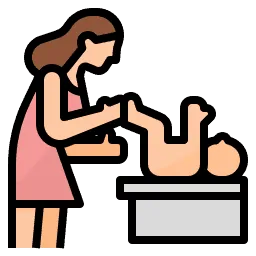Did your little one just pass their first bowel movement, and you’re worried the color isn’t normal? Baby poop comes in nearly every hue and texture imaginable.
Most parenting manuals don’t warn you that you’ll spend the next few years obsessing over your baby’s diaper contents. However, looking in the diaper provides great insight into your baby’s health.
We will break down the different types of baby poop, explain what is normal, and highlight exactly what you should look out for.
Key Takeaways
- Newborns: First poops (meconium) are tar-like, greenish-black, and very sticky.
- Breastfed: Stool is mustard-yellow, runny, and often seedy with a sweet smell.
- Formula-Fed: Poop is thicker (like peanut butter), darker tan or brown, and smellier.
- Warning Signs: White, red, or black stools (after the newborn stage) require medical attention.
Types of Baby Poop and What They Mean

There are five main categories of baby poop: newborn, breastfed, formula, solid, and partially digested.
Your baby’s bowel movements depend entirely on their diet.
Let’s look closer at the types:
1. Newborn Poop (Meconium)
During your baby’s first few days, they pass a tar-like, greenish-black poop known as meconium (1). It is incredibly sticky and resembles motor oil. It looks alarming, but it is completely normal.
Meconium consists of everything your baby ingested in the uterus, including amniotic fluid, skin cells, and mucus. It does not contain breastmilk or formula yet. Most infants pass meconium within the first 24 hours of life.
After two to four days, the meconium transitions. Expect a lighter, army-green color and a less sticky texture. This signals that your little one’s intestinal tract is working and they have begun digesting milk.
Sometimes, babies pass meconium before delivery due to stress or being overdue. This turns the amniotic fluid green or brown. If this happens, the medical team will monitor your baby closely to prevent meconium aspiration syndrome, a potentially serious lung condition (2).
If your baby does not poop within 24 hours of birth, doctors will check for blockages or other issues like an underdeveloped anus or a “meconium plug.”
2. Breastfed Poop
Healthy breastfed baby poop is yellow or slightly green. It has a creamy, mushy consistency and is often textured with seed-like flecks. It looks like loose Dijon mustard mixed with cottage cheese.
The consistency varies. It is often runny enough that new parents confuse it with diarrhea (3). Breastfed poop changes based on the mother’s diet. Expect small “squirts” during feedings and larger explosions between them.
Do not panic if the poop looks greener than usual. Retrace your recent meals. As long as your baby has no fever or vomiting, a slight color change is usually fine.
3. Formula-Fed Poop
Formula-fed poop differs from breastfed stool. It is denser, paste-like, and browner. Colors range from yellow-brown to tan or greenish-brown. The texture is often compared to peanut butter.
Formula-fed babies typically poop less frequently than breastfed babies, but the volume is significantly larger.
4. Solid-Fed Poop
As you introduce solid foods like cereal or pureed vegetables around four to six months, the poop changes drastically.
The consistency becomes thicker, firmer, and darker. This change is especially noticeable if you have been exclusively breastfeeding up to this point. The smell will also become much stronger.
5. Partially Digested Poop
Once your baby eats finger foods like carrots or blueberries, you will likely see chunks in the diaper (4). The poop might be red from beets, blue from berries, or green from spinach.
Visible food chunks are normal. Your baby’s stomach is still learning to digest solids, and some food passes through quickly. You might also see skins from grapes or corn.
This also happens because babies often swallow food before chewing it properly, especially if they don’t have many teeth yet.
Baby Poop Colors and What They Mean

Baby poop comes in a rainbow of hues. It is easy to be surprised by a sudden change.
Knowing what the colors mean is crucial, as some indicate health issues while others are just a result of dinner.
1. Black
Black is normal during the first few days (meconium).
However, black poop is not normal if it appears later in infancy. If you see black stool after the meconium phase, check if your child ate Oreos, licorice, or grape juice. Iron supplements or bismuth medicines (like Pepto-Bismol) can also turn stool black.
If diet or medicine isn’t the cause, black, tarry poop can indicate bleeding in the upper digestive tract. This condition, called melena, occurs when stomach acid turns blood black and sticky (5). Contact your doctor immediately if you see this.
2. Green
Green stools are rarely a cause for panic. Dark green poop is often confused with black under poor lighting. Smear a little on white paper to check the true hue.
Dark green is generally caused by bile or green vegetables like spinach.
Babies with diarrhea may also have green stools due to rapid digestion. If your baby seems sick or the green poop persists, call your pediatrician.
In clinical practice, I frequently see green stools when infants have an upper respiratory infection. Streaks of mucus can be noted within the green stool. Since infants cannot blow their noses or expel nasal mucous any other way, they swallow it and pass it in their stools. If there is blood along with the mucous, it is an entirely different problem and should be discussed with your pediatrician.
Editor's Note:
Dr. Leah Alexander, MD, FAAP3. Red
Red scares parents because it looks like blood. Fortunately, diet is the usual suspect.
Red foods like beets, tomatoes, fruit punch, or Jell-O often dye the stool. In fact, 90 percent of “bloody poop” scares are not actually blood. Antibiotics like Amoxicillin can also turn stool red.
When I prescribe the antibiotic Cefdinir, I always warn parents to expect a change in stool color. (6)
Editor's Note:
Dr. Leah Alexander, MD, FAAPIf it is blood, it might not be from the baby. A breastfeeding mother with cracked, bleeding nipples can pass blood that the baby swallows and poops out.
However, red blood can indicate a lower gastrointestinal issue or a milk protein allergy. This often appears around 2 to 3 weeks of age, accompanied by excessive crying or poor weight gain. If you see blood mixed with mucus, call your doctor. You may need to switch to hypoallergenic formula or eliminate dairy from your diet (7).
4. Mustard Yellow
Mustard yellow signals the end of the meconium phase. It shows your baby is digesting breastmilk or formula properly.
This color is the gold standard for breastfed babies. Formula-fed babies usually have darker, browner stools.
5. Bright Yellow
Bright yellow is another normal variation for breastfed babies.
However, if the poop is extremely runny, explosive, or happens much more frequently than usual, it could be diarrhea. Diarrhea in infants is serious because it leads to dehydration quickly (8).
6. Orange
Orange poop usually comes from pigments in food. It is common after a meal of pureed carrots or sweet potatoes.
This is generally nothing to worry about unless your baby has a fever or other signs of illness.
7. Greenish Tan
This muddy color is standard for formula-fed babies and those starting solids.
It is less common in exclusively breastfed babies but is rarely a sign of a problem on its own.
Baby Poop Warning Signs

Not all textures and colors are safe. Your baby’s diaper serves as an early warning system for their health (9).
Watch out for these specific warning signs:
1. White or Gray Poop
Call your doctor immediately. White or chalky gray poop indicates the liver is not producing enough bile. Bile gives poop its brown color.
A lack of bile can signal serious liver disease (like biliary atresia) or a blocked bile duct. This is a medical emergency (10). Note that dark gray usually relates to solid foods and is less concerning, but chalky white/gray is always a red flag.
2. Foamy Stool
Frothy or foamy poop often happens when a baby has a “lactose overload.” This occurs when a baby gets too much foremilk (the lower-fat milk at the start of a feed) and not enough hindmilk (the higher-fat milk) (11).
To help, ensure your baby drains one breast fully before switching to the other. This ensures they get the rich, fatty milk that slows digestion. If frothy poop persists, consult your pediatrician.
3. Stringy or Mucous Poop
If the poop contains slimy, stringy streaks (often green), it contains mucus.
This is common when babies are teething due to excessive swallowed saliva. However, mucus can also indicate an infection or allergy. If it persists or comes with a fever, call the doctor.
4. Hard Pebbles
Small, hard, dry pellets are a clear sign of constipation. Passing these is often painful for the baby.
Constipation often happens during the switch to formula or solids. It is a fluid issue. For babies over 6 months, small sips of water can help. For younger babies, offer more frequent feeds.
You might see small streaks of bright red blood on the outside of the stool; this is usually from a small tear (fissure) in the anus caused by straining (12).
Avoid giving juice to treat constipation unless your doctor specifically advises it. The AAP recommends fruit purees (prunes, peaches, plums) over juice (13).
5. Red Bloody Stool
Aside from anal fissures, blood in the stool can indicate a milk protein allergy or a bacterial infection. If the poop looks like “currant jelly,” it could signal intussusception, a serious intestinal blockage (14). Always have a doctor check bloody stool.
6. Runny Watery Stool
Newborn poop is naturally soft, but if it becomes waterier than usual, green, or explosive, it is likely diarrhea.
Untreated diarrhea causes dangerous dehydration. Call your pediatrician for advice on keeping your baby hydrated.
Always Consult A Doctor
How Often Should Baby Poop?

Frequency depends heavily on whether your baby is breastfed or formula-fed.
Remember that every baby has their own “normal.”
Breastfeeding Babies
In the first few weeks, breastfed babies often poop after every feeding. It is a sign they are getting plenty of milk.
around six weeks old, this pattern changes. Breast milk is so easily digested that there is very little waste left. Some breastfed babies may go 7 to 10 days without pooping.
As long as the eventual poop is soft and your baby is comfortable, this long gap is completely normal (16).
Formula-Fed Babies
Formula takes longer to digest. Formula-fed babies typically poop once or twice a day.
However, they can also go a day or two without a movement. The key is consistency. If the stool is soft, they are fine. If it is hard or they strain excessively without success, they might be constipated (17).
Why Isn’t Baby Pooping?

A lack of poop doesn’t always mean constipation.
Experts agree it is normal for a 2- to 3-month-old to go a week without a bowel movement (18).
Breastfed babies go longer because breastmilk leaves little residue. Formula-fed babies are slightly more prone to constipation because formula is harder to digest.
True constipation usually presents with a hard, distended belly and a very uncomfortable baby.
Common Causes of Constipation
Constipation often strikes during dietary transitions: switching from breast to formula, or starting solids. The digestive system needs time to learn how to process firmer food.
The most common offending foods that I see in practice are white rice cereal and bananas. I often recommend brown rice cereal instead which has more fiber.
Editor's Note:
Dr. Leah Alexander, MD, FAAPAt 12 months, the introduction of cow’s milk is a major constipation trigger. Cow’s milk is binding. Limit intake to about 16-24 ounces a day for toddlers. Too much milk fills them up, causing them to eat less fiber-rich food, and can even cause iron-deficiency anemia (19).
If you are transitioning a toddler, load up on veggies and fruits. Fiber acts as a natural laxative.
If your baby is truly constipated, try these remedies:
- Belly massage: Gently massage the abdomen in a clockwise motion to help move gas and stool along.
- Warm bath: A warm bath relaxes the muscles and can help stimulate a bowel movement.
- Bicycles: Lay your baby on their back and gently cycle their legs toward their tummy.
- Consult your doctor: If these don’t work, ask your pediatrician. They may suggest a glycerin suppository or a small amount of fruit juice (20). Do not use laxatives or enemas without medical supervision (21).
Types of Baby Poop Smells

New parents are often shocked by the variety of odors coming from such a small person.
The smell generally correlates directly with what went in.
1. Newborn Smell
Meconium is sterile and virtually odorless. Enjoy this brief phase, because once bacteria colonize the gut during the first feeding, the smell arrives.
2. Breastfed Smell
Breastfed poop is surprisingly mild. Many parents describe it as sweet or yeasty, smelling like hay, popcorn, or pancake batter.
If the stool smells extremely foul (like rotten eggs) and is watery, it could indicate a virus like Rotavirus (22).
3. Formula Smell
Formula poop smells stronger and more pungent than breastfed poop. Because formula is harder to digest, there is more waste product, resulting in an odor closer to adult stool.
4. Solid Food Smell
Once solids enter the picture, the “baby smell” vanishes. Poop will smell like adult poop, sometimes worse depending on what they ate (broccoli and meat are major offenders).
Babies’ Poop Faces

That grimace your baby makes is adorable, but it also tells a story.
Here is how to decode the “poop face”:
1. The Scrunch
Red face, grunting, and scrunched eyes usually mean gas or constipation. If they are crying while doing this, they might be in pain. Try the bicycle leg movement to help them out.
2. The Pout
A pouty lip often means they are working hard but nothing is happening. This is common when introducing solids. They are getting used to the sensation of passing firmer stool.
3. The Relief
If your baby suddenly smiles or looks incredibly relaxed after a period of focus, check the diaper. That is the face of success.
4. The Stare
Sometimes babies freeze and stare into the distance. They get hyper-focused on the internal sensation. Do not interrupt; let them finish their business!
Baby Poop FAQs
The Poop Scoop

Baby poop is a weird and wonderful world that changes month by month.
It might seem gross now, but you will soon become an expert at analyzing diapers.
From sticky black meconium to the mustard-yellow of breastfeeding and the peanut butter texture of formula, every stage is different.
Keep an eye out for the red flags: white, chalky gray, bloody, or hard pebble stools. These warrant a call to the pediatrician. Otherwise, keep plenty of wipes handy and try to laugh at the poop faces. You’ve got this!


















